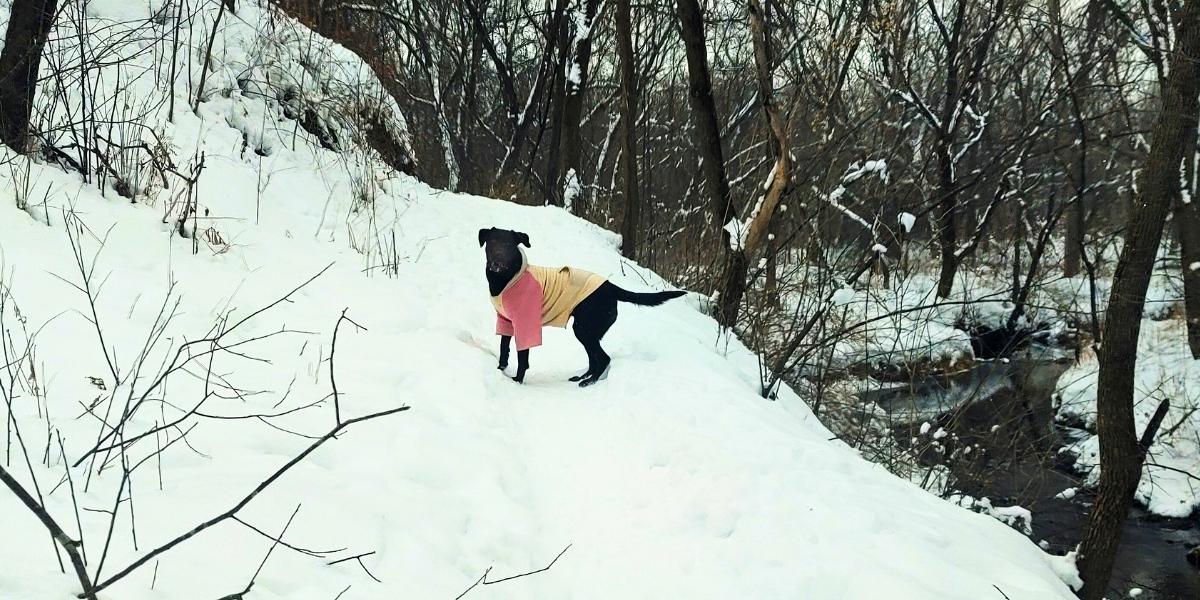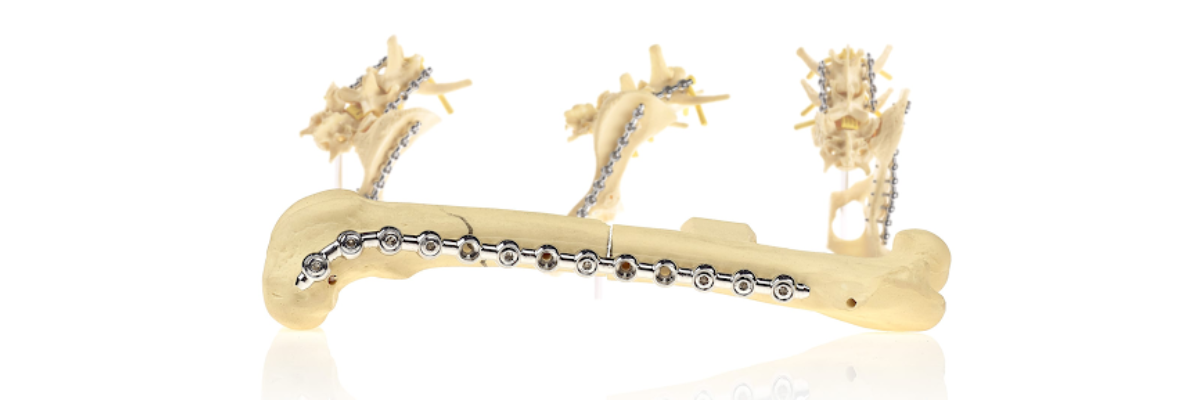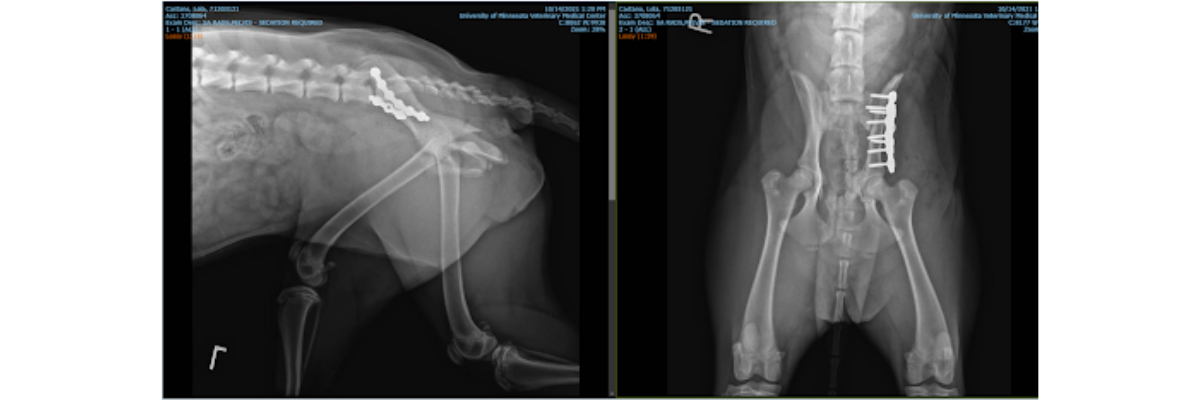A string of pearls for Lola
Surgical implant gets Labrador back her feet after being hit by a car

Surgical implant gets Labrador back her feet after being hit by a car
Lola, a black Labrador, plays in the snow during a walk. Photo courtesy of Zelene Castano.
Feelings of panic and urgency gripped Zelene Castano and her husband as they rushed toward the local veterinarian’s office on a morning in October 2022.
Lola, their 9-month-old black Labrador, had darted into the street and entered the path of an oncoming truck. The truck driver had not seen her in time, striking Lola and dragging the young dog a distance of about three houses before their shouts brought his vehicle to a stop.
When they arrived at the veterinarian’s office, an exam revealed Lola’s injuries were quite extensive and would require complicated surgery to repair. Their veterinarian referred them to the Veterinary Medical Center at the University of Minnesota where surgeons were well-trained and staffed to perform the difficult surgery.
While her heart and emotions were all over the place, Castano says she felt hopeful upon arrival at the VMC.
“I knew Lola was going to be in good hands when we walked in and everyone seemed so caring and reassured me that they could help Lola one way or another,” she says.
Clinicians at the VMC took additional X-rays to determine the surgical steps needed to help Lola recover from her hip trauma. Images confirmed multiple broken and displaced bones in the hip, pubic region, the sacroiliac joint linking the pelvis and lower back, and the acetabulum—the ball-and-socket joint where the thigh bone meets the hip.
A member of Lola’s surgical team, Dr. Shelly Shamir, explained that pelvic or hip fractures are not as common as other types of fractures they see in the clinic.
“For a pelvic fracture like this, the clinic probably sees a handful or so a year,” she says. “In general, I would not be surprised if the clinic sees three to four limb fractures every week.”
The best chance for Lola to recover and continue to run, play and chase her favorite ball, free from pain or a severe limp, would be surgery to repair her broken bones. Surgeons would use a device known as a string of pearls (SOP) to repair and stabilize two of the fractures. Known for its strength and flexibility, the SOP plate is a series of alternating cylinders and spheres (pearls) that bend and twist to stabilize broken bones. The flexibility of the implant offers a superior fit and better movement for the animal.

Lola’s surgery took a team of four surgeons and three anesthesiologists approximately 4.5 hours. When surgeons got down to the level of the fracture in surgery, Lola had another incomplete fracture line that had not been seen on the X-ray, which made the reduction and surgical repair a little more challenging. Lola’s fracture made a V-shape which required two plates to repair instead of one. With her fractures stabilized, Lola had months of recovery ahead of her.
“Most of these injuries will heal in about eight weeks or so, and I see most dogs start to return to normal function approximately three to four after surgery, sometimes longer,” Shamir says.
The treatment for Lola’s injuries would prove to be costly. To help offset the medical bills, the Castanos pooled their resources with funding provided to them through the VMC Companion Animal Emergency Fund. For nearly 18 years, this fund provides financial assistance to qualifying clients whose pets come to the Lewis Small Animal Hospital’s Emergency and Critical Care Service seeking treatment for urgent situations.
Shamir explains that it can be challenging to determine the best course of treatment when limited financial resources are available to treat a client.
“In Lola’s case, we prioritized applying finances available towards fixing the most important fracture, which was her ilial body fracture,” she says. The ilial body is the uppermost part of the hip bone and the fracture was along the weight-bearing axis—the absolute priority for repair.

With financial challenges overcome, the Castanos could focus on Lola’s recovery. Up and walking on both legs the day following surgery, Lola was able to go home after spending just two days in the hospital. During recovery at home, the Castanos were tasked with keeping their young and energetic dog quiet and confined for six to eight weeks with absolutely no running, jumping, or playing permitted.
Now, the Castanos happily report she is doing well.
“She has no struggles,” Castano says. “She’s energetic, plays, and loves going to the dog park to run. She especially loves spending time with her human sister and brother, and with her canine cousin.”
The Castanos are grateful for all of the help Lola received at the VMC, thanking the staff who make them feel comfortable the moment they walked in the door, the surgeons and residents who treated Lola, the technicians who kept Lola comfortable and feeling pampered, and, especially, the donors who generously helped to meet the expenses of emergency surgical care and a hospital stay.
Initiated nearly 18 years ago, the VMC Companion Animal Emergency Fund provides financial assistance to qualifying clients whose pets come to the Lewis Small Animal Hospital’s Emergency and Critical Care Unit seeking treatment for critical situations.
If you're interested in financially supporting financial assistance funds such as the VMC Companion Animal Emergency Fund to help more pets like Lola, you can contact Development Officer Will Haugen at hauge442@umn.edu for more information.